Antique jewelry is a term that refers to pieces of jewelry that are at least 100 years old, or sometimes older than that. Antique jewelry can be classified into different periods, such as Georgian, Victorian, Edwardian, Art Nouveau, Art Deco, and Retro. Each period has its own distinctive styles, materials, techniques, and motifs that reflect the historical and cultural context of the time.
Some of the most popular and fascinating types of antique jewelry, and share some tips on how to identify, buy, and care for them.
Antique Jewelry
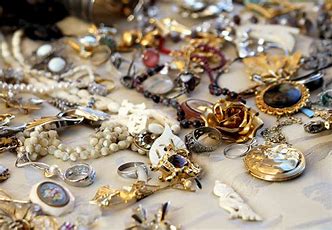
Georgian Antique Jewelry (1714-1837)

Georgian jewelry is one of the oldest and rarest types of antique jewelry. It was made during the reigns of four British kings named George, from 1714 to 1837. Georgian jewelry is characterized by intricate designs, elaborate craftsmanship, and high-quality materials. Some of the common motifs include flowers, leaves, birds, insects, ribbons, bows, and hearts.
Georgian jewelry was mostly handmade by skilled artisans, using techniques such as repoussé, chasing, engraving, and filigree. The metals used were mainly gold and silver, often with a high karat value. The gemstones used were mostly diamonds, rubies, sapphires, emeralds, pearls, coral, and turquoise. The diamonds were usually rose cut or table cut, and the colored stones were often foiled to enhance their brilliance.
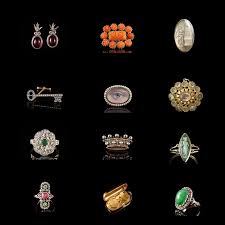
Georgian jewelry is very scarce and valuable today, as many pieces were melted down or altered over time. To identify Georgian jewelry, look for signs of handwork, such as uneven shapes, solder marks, and tool marks. Also look for closed-back settings, foiled stones, and natural pearls.
Victorian Jewelry (1837-1901)
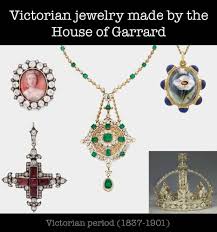
Victorian jewelry is named after Queen Victoria of England, who reigned from 1837 to 1901. Victorian jewelry is influenced by the queen’s personal taste, as well as the social and technological changes of the era. Victorian jewelry can be divided into three sub-periods: Early Victorian (1837-1860), Mid-Victorian (1860-1885), and Late Victorian (1885-1901).
Early Victorian jewelry is also known as Romantic jewelry. It reflects the queen’s love for her husband Prince Albert, and her fascination with nature. Early Victorian jewelry features delicate designs, sentimental motifs, and colorful gemstones. Some of the common motifs include flowers, hearts, locks, keys, snakes, and hands.
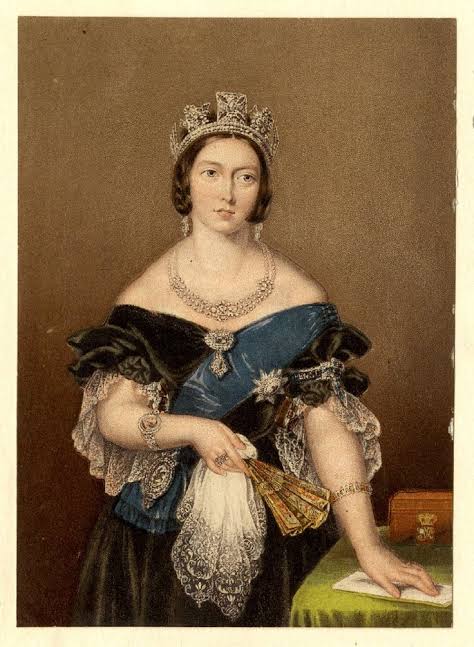
Mid-Victorian jewelry is also known as Grand or Mourning jewelry. It reflects the queen’s grief after the death of Prince Albert in 1861 and her respect for the fallen soldiers of the Crimean War. Mid-Victorian jewelry features dark colors, somber designs, and mourning symbols. Some of the common motifs include crosses, anchors, cameos, jet beads, and hairwork.
Late Victorian jewelry is also known as Aesthetic or Art Nouveau jewelry. It reflects the queen’s optimism and interest in art and culture at the end of her reign. Late Victorian jewelry features whimsical designs, organic shapes, and exotic influences. Some of the common motifs include butterflies, dragons, fairies, and peacocks.
Victorian jewelry was made with a variety of metals, such as gold, silver, platinum, and base metals. The gemstones used were mostly diamonds, opals, turquoise, garnet, amethyst, and coral. The diamonds were usually old mine cut or old European cut, and the colored stones were often cabochon or rose cut. To identify Victorian jewelry, look for clues such as date marks, hallmarks, maker’s marks, and patent numbers. Also look for specific styles, such as snake rings, mourning brooches, locket pendants, and crescent moon earrings.
Edwardian Jewelry (1901-1915)
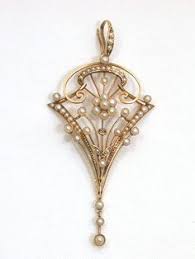
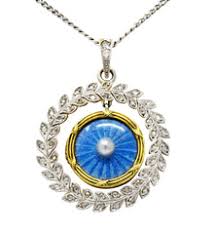
Edwardian jewelry is named after King Edward VII of England, who reigned from 1901 to 1915.
Edwardian jewelry is influenced by the king’s lavish lifestyle and his admiration for French fashion and culture. Edwardian jewelry is also known as Belle Époque or Garland jewelry. It reflects the elegance, refinement, and sophistication of the era.
Edwardian jewelry features delicate designs, intricate craftsmanship, and luxurious materials. Some of the common motifs include garlands, bows, swags, tassels, and lace.
Edwardian jewelry was mostly made with platinum, which was a new and rare metal at the time. Platinum allowed for finer and lighter settings and enhanced the sparkle of diamonds. The gemstones used were mostly diamonds, pearls, emeralds, sapphires, and rubies. The diamonds were usually old European cut or transitional cut, and the colored stones were often calibré cut or marquise cut. To identify Edwardian jewelry, look for signs of platinum work, such as migraine, piercing, and millefiori. Also look for specific styles, such as lavalieres, dog collars, sautoirs, and tiaras.

Art Deco Jewelry (1915-1935)
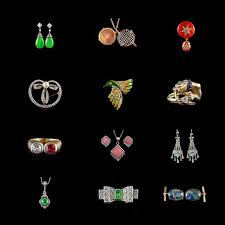
Art Deco jewelry is named after the Exposition Internationale des Arts Décoratifs et Industriels Modernes, which was held in Paris in 1925.
Art Deco jewelry is influenced by the artistic and cultural movements of the time, such as Cubism, Futurism, Bauhaus, and Art Nouveau.
Art Deco jewelry is also inspired by the technological and social changes of the era, such as the rise of automobiles, airplanes, radios, and cinema.
Art Deco jewelry features geometric designs, bold colors, and contrasting materials. Some of the common motifs include sunbursts, fans, zigzags, chevrons, and pyramids.
Art Deco jewelry was made with a variety of metals, such as platinum, white gold, yellow gold, and base metals. The gemstones used were mostly diamonds, emeralds, rubies, Sapphires, onyx, jade, coral, and turquoise. The diamonds were usually modern round brilliant cut or single cut, and the colored stones were often baguette cut or trapezoid cut. To identify Art Deco jewelry, look for clues such as maker’s marks, country of origin, and patent numbers. Also look for specific styles, such as cocktail rings, chandelier earrings, bib necklaces, and brooches.
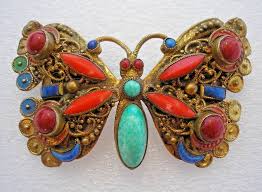
Retro Jewelry (1935-1950)
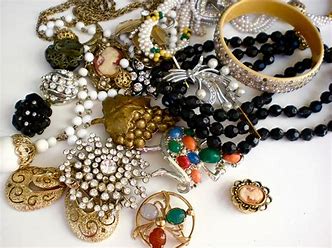
Retro jewelry is named after the period between the late 1930s and the early 1950s when World War II affected the production and consumption of jewelry. Retro jewelry is influenced by Hollywood glamour, the military style, and the post-war optimism of the era. Retro jewelry is also known as Cocktail or Hollywood jewelry. It reflects the flamboyance, femininity, and fun of the time.
Retro jewelry features large designs, bright colors, and mixed metals. Some of the common motifs include flowers, bows, ribbons, stars, and hearts. Retro jewelry was mostly made with gold, which was more available and affordable than platinum during the war. The gold was often rose or green in color, and textured or engraved for added interest. The gemstones used were mostly diamonds, rubies, sapphires, aquamarine, citrine, amethyst, and synthetic stones. The diamonds were usually modern round brilliant cut or single cut, and the colored stones were often oval cut or emerald cut. To identify Retro jewelry, look for signs of goldwork, such as stamping, engraving, and plating. Also look for specific styles, such as charm bracelets, ballerina rings, bow brooches, and ear clips.
Tips for Buying and Caring for Antique Jewelry
Antique jewelry is a great way to add some history, personality, and uniqueness to your collection. However, buying and caring for antique jewelry can be challenging if you are not familiar with the basics. Here are some tips to help you enjoy your antique jewelry for years to come:
– Do your research. Before you buy any piece of antique jewelry, make sure you know its age, origin, condition, value, and authenticity. You can also consult with reputable dealers or appraisers who can provide you with expert advice and documentation.
– Inspect the piece carefully. When you buy any piece of antique jewelry, examine it closely for any signs of damage, repair, alteration, or wear. Look for cracks, chips, scratches, dents, breaks, or missing parts. Check the settings, clasps, hinges, pins, and chains for any looseness or weakness. Test the functionality and safety of the piece by trying it on and moving it around.
– Buy what you love. Antique jewelry is not only an investment but also a personal expression. Therefore, buy what you love and what suits your style and taste. Don’t be swayed by trends or prices alone. Choose pieces that speak to you and that you will enjoy wearing and displaying.
– Store it properly. Antique jewelry is delicate and needs proper storage to prevent damage or deterioration. Store your antique jewelry in a clean dry and cool place away from direct sunlight heat moisture and dust. Use soft-lined and separate box pouches or compartments to store each piece individually to avoid scratches tangles or tarnish. You can also use acid-free tissue paper cotton or silica gel packets to protect your antique jewelry from humidity.
Photo credit Pinterest
Recommended1 recommendationPublished in apparel, celebrity fashion, Jewelry, Our Fashion Passion, Pop Fashion





